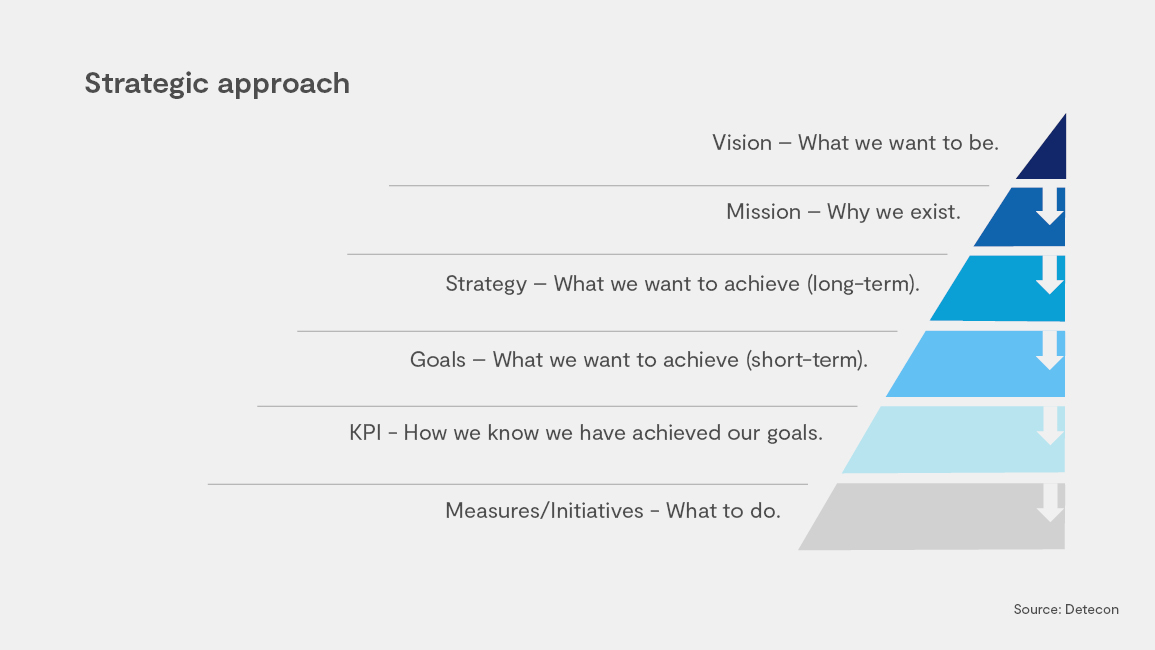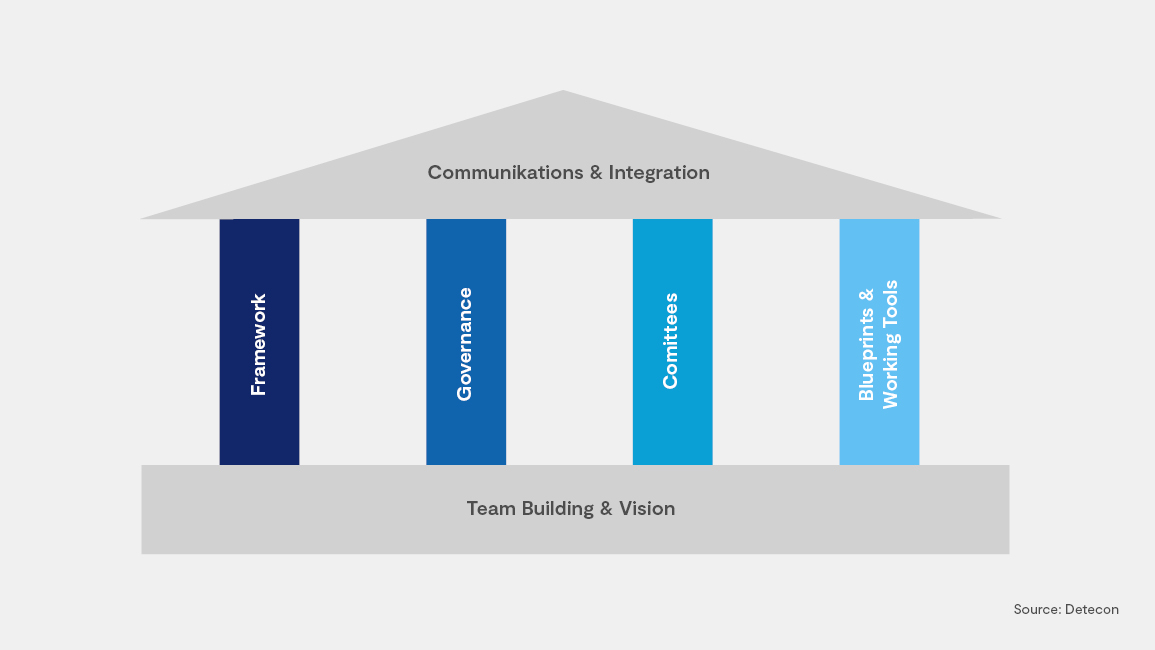Poorly defined business processes and a lack of transparency are repeatedly mentioned as obstacles that hamper the progress of digital transformation. Both can be overcome with the aid of strategic process management.
The strategic process management is a corporate unit that concentrates on business processes across the full breadth of the organization and company. It implements the specifications of the corporate strategy in all business processes and initiates measures to improve processes and exploit their potential for success.
Since processes are omnipresent within a company, it is important to set up suitable process management before optimizing existing processes. Strategic process management thus combines the corporate vision with the actual steps that need to be taken within a company (operational process management) in order to follow a strategy or achieve corporate goals.

Before introducing strategic process management, it is crucial to clarify the objectives. In vision and strategy workshops, a structured assessment can be made of how future strategic process management should be aligned and which strategic topics it should cover.
Core components of SPM
In addition to the overarching goal of strategic process management to implement the general corporate strategy, there are also subordinate goals of strategic process management that should be achieved.
1. Create transparency across complex process landscapes
By implementing a process model, governance, and policies and guidelines for role description and process modeling, strategic process management contributes significantly to the creation of transparency, support of the corporate strategy, and the success of the company.
The standardized, hierarchical mapping of processes and process steps lays the groundwork for successful business process analyses and optimization in complex process landscapes; in brief, strategic process management is a decisive factor for the successful implementation of a digitalization strategy.
In this respect, it is important that roles, responsibilities, accountabilities, and criteria for process releases are clearly defined and described by strategic process management so that the cooperation with all involved units and the decision-making and escalation paths are all clearly regulated.
2. Focus on the client
Successful companies always focus on the customer, so customer-to-customer processes such as request-to-offer, order-to-cash, or fault-to-restoration are especially significant for strategic process management.
The value chains that generate added value for the customer are mapped by the cross-organizational business processes. Besides the customer-to-customer processes, a distinction must be made between service processes that map the service portfolio (such as products and solutions that are provided or operated for the customer or the commercial processing of orders) and the “classic” support processes that facilitate business operations such as procurement, human resources management, and finance processes.
Operational process management, which is maintained in the appropriate business units, supports strategic process management, and it is these management structures in the business units that are in charge of operating, modeling, analyzing, designing, and measuring the service and support processes. Successful interaction of strategic process management with operational process management guarantees a holistic, process-related representation of the company and creates the prerequisites for successful digital transformation.
3. Continuous process improvement
Faced with international competition and cost pressure, companies must work effectively and efficiently. Strategic process management should ensure that processes are not modeled only once or for the purpose of documentation, but are continuously monitored (e.g., by process mining) and improved whenever possible. Thanks to its higher-level position, strategic process management is able to identify any synergies that can be realized across product and process boundaries.
4. Process digitalization and automation
Companies should also consider process digitalization and automation measures that could possibly enhance efficiency even further. For instance, software solutions and software robots based on robotic process automation can not only complete tasks in less time and with higher quality, but also relieve employees of tedious, repetitive tasks. Strategic process management should collaborate closely with the IT department to ensure the expedient use of intelligent tools in the processes.
5. Establishment of a process community
Strategic process management should also focus on establishing a strong process community. Only close interaction among process modelers, business and product representatives, and IT departments can ensure a high level of process quality that is actually sustainable. In this sense, strategic process management should serve as a facilitator and moderator, constantly providing formats and touchpoints that will promote interaction and establish shared values.
Moreover, experience also indicates that strategic process management should devote more of its attention to strengthening user and customer journeys. The interface with the competent business units, insofar as one exists, must be strengthened. Finally, strategic process management should ensure that certification procedures are performed without any mishaps and that the required certificates are properly obtained.
Once the strategic topics have been defined, they should serve as the benchmarks for the daily activities of strategic process management. One recommendation is to pursue the OKR approach with the aim of drawing tangible short-term goals and metrics or KPIs from the defined topics. The initiatives and activities of strategic process management should in turn support these metrics or KPIs so that a clear link is established between vision, strategy and the activities of the business.

Instruments of strategic process management
The following instruments are particularly effective during the successful implementation of the previously defined strategy:
- Process framework
- Process governance
- Process improvement committees
- Process blueprints and tools
The process framework is the general structure defined by the company, i.e., a mapping of all company processes (customer-to-customer, business, and support processes). It renders a company’s process landscape transparent and supports the company’s standards and goals.
The granularity of the processes in the process framework should increase during the top-down movement from one process level to the next. In addition, responsibilities in the process units must be clearly assigned and cooperation among the units must be fostered by the structures of the strategic process management. The key added value of the framework is the creation of a single source of truth for processes that ensures clarity of process flows in the complex organization.
Another major component found alongside the process framework in the strategic process management toolkit is process governance. Process governance ensures that all process development and improvement initiatives are fully aligned with the company’s business objectives and overall business strategy. It includes the guidelines marking the boundaries within which the company operates in terms of processes, ensuring the success of process management initiatives within the organization. Since the process owners subsequently work in accordance with standardized rules, the high quality of the processes is ensured.
Yet another instrument of strategic process management are process improvement committees. One example is a process improvement team (PIT), a body of process experts from multiple disciplines pursuing the goal of realizing synergy effects in the process landscape. Group membership should comprise representatives from the business processes, IT, process modeling, and business activities alongside strategic process managers, all of whom should be actively engaged in interaction with one another. The collaboration should be organized so that process topics can be raised during regular meetings, in share points, and on portals. The added value of such committees is generated during the continuous evolution and improvement of the process landscape.
The development of process blueprints and tools as supplements to the other instruments is expedient for the rollout of strategic process actions in the company. Process blueprints are broad representations of process flows presented in the graphic form of a generalized process diagram; in the majority of cases modeled in BPM/N 2.0. The blueprints are fleshed out by the addition of task content, instructions for communicating and interacting with customers, other process roles, and input/output factors and descriptions of the process role performing each task. This type of presentation generates added value because potential improvements can be more easily identified and implemented. Moreover, the blueprints can be used as templates for future process mapping. The provision of other tools as necessary to complement the blueprints for operational process management is also useful.
There are, of course, even more instruments that can be used in addition to the ones described above. The choice of instruments that promise success will depend on the specific circumstances of any given company.
Implementation of strategic process management
The structure of the strategic process management in any specific instance is ultimately a function of multiple framework parameters such as the size of the organization, its vertical range of manufacture or the quantity of products and services produced by the company. Nevertheless, certain basic steps should be considered whatever the environment when setting up strategic process management.
1. The foundation: team building and vision
The first important step is to develop a shared vision within the strategic process management team. We described how this can be achieved in section "Goals of strategic process management". In addition to the development of the vision, there should be a strengthening of the bonds among team members (by conducting team-building measures, for instance) and the allocation of the tasks within the team according to the strengths of the team members. The result is a strong foundation that serves as an anchor not only for the strategic process management but for the entire process community.

2. The pillars: initial development of the strategic process management tools
Once the foundation for collaboration has been laid, the next step is the initial development of the tools described in section "Instruments of strategic process management". There is a certain amount of preliminary work concerning the structure of the framework, governance, committees such as the PIT, and the tools that will be provided that must be completed before they can be announced.
An essential element is that the tools are not only developed internally, but that experts from the organization are involved wherever this seems expedient. Besides assuring the high quality of the instruments, this approach facilitates their acceptance by the target users. Once their initial creation is complete, the final formality should be the approval of the tools by the management, which will serve to anchor them firmly in the company.
It must be noted, however, that the instruments should continue to “live” after their initial creation. The organization and the strategic process management never stop learning, and this should also be reflected in the instruments.
3. The roof: intensive communication with stakeholders and integration with process-related units
Once the unit is in operational mode and the tools have been established, the next step should be to publicize strategic process management within the organization. As it is a central unit that can exist solely in interaction with its addressees, intensive communication is a prerequisite for its success. The content and presence of the strategic process management can be firmly anchored in the minds of the process community solely by means of internal campaigns.
Suitable communication measures may include intranet sites, newsletters, lessons learned sessions, or training courses. Depending on how forcefully the organization is impacted by the implemented changes, further consideration should be given to the possible necessity of a change management program. The integration with units closely involved with the processes is required in addition to the communication activities aimed at the addressees of the strategic process management.
The interaction with product management and IT is especially important because, for one, the requirements of strategic process management must be an integral part of the development of the new product processes and, for another, processes in today’s world can no longer be imagined without the underlying IT.
Even after it has been established, strategic process management should continue to perform its strategic role as a driving force and positive role model in process management. New trends such as process mining or various process automation mechanisms are continuously emerging.
Strategic process management should, in close coordination with operational process management, critically examine the extent to which these trends can be integrated into the existing process landscape in order to ensure the future viability of process management and the company.
We would like to thank Lucas Wagner for his contribution to this article!










